Abstract
A survey carried out to detect children with aniridia/Wilms's tumour syndrome identified 8 living and 3 dead children. The incidence of aniridia was found to be 1 in 43 among Wilms's tumour patients in the UK. The clinical features included complete bilaterial aniridia, cataracts, glaucoma, mental retardation, hyperkinesis, hypospadias, and undescended testes. A high incidence of bilateral tumours (36%), male sex, presentation at a young age, and advanced maternal age appeared to be associated with the syndrome. The 8 living children each had a deletion on the short arm of chromosome 11. In contrast, although 2 patients with sporadic aniridia without Wilms's tumour had other malformations, neither had genitourinary anomalies, and the only additional problems in patients with familial aniridia were cataracts. Among 49 children with Wilms's tumour without aniridia ony one had bilateral tumours. No chromosome abnormalities were detected in patients with familial aniridia, nor were they detected in patients with Wilms's tumour without aniridia or in those with sporadic aniridia without Wilms's tumour. While many infants with the Wilms's tumour/aniridia syndrome are clinically diagnosable at birth, chromosome analysis using the elongated chromosome method is especially valuable to confirm the diagnosis in girls with sporadic aniridia and in boys who lack the genitourinary malformations. The presence of an 11p13 deletion confirms the diagnosis of the Wilms's tumour/aniridia syndrome and indicates a very high risk for the development of Wilms's tumour.
Full text
PDF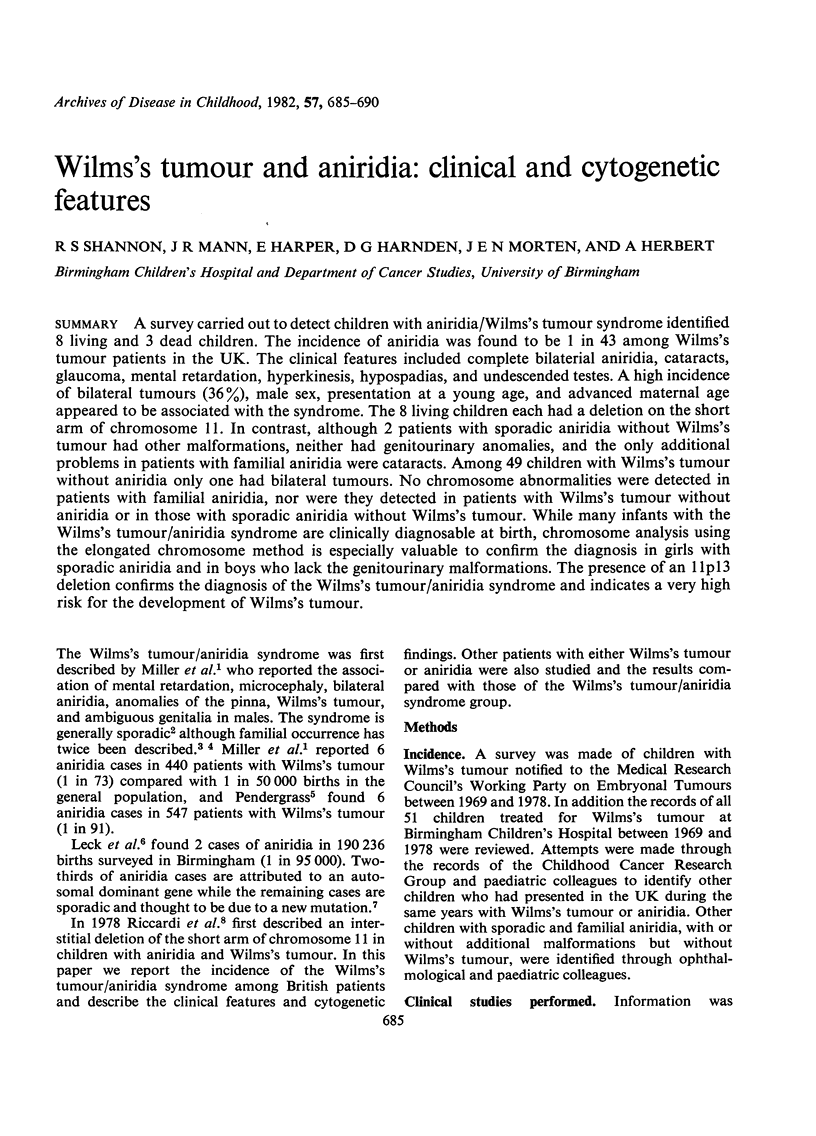
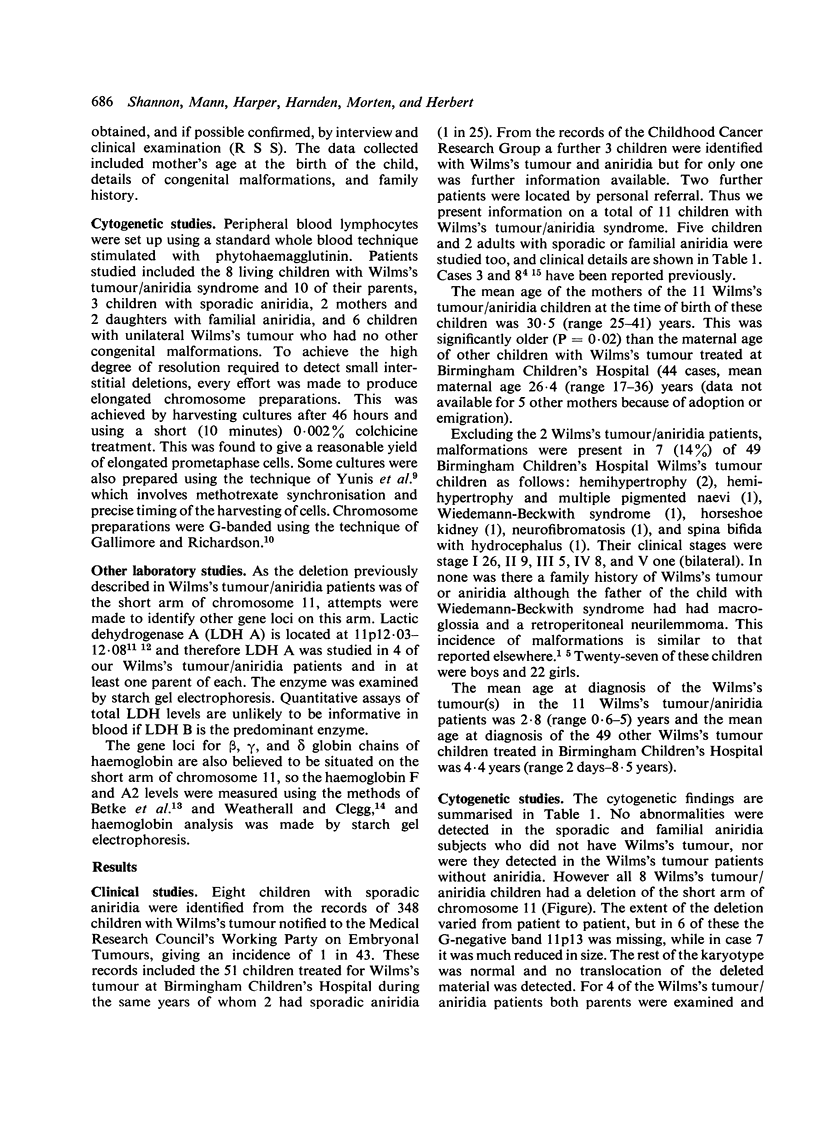
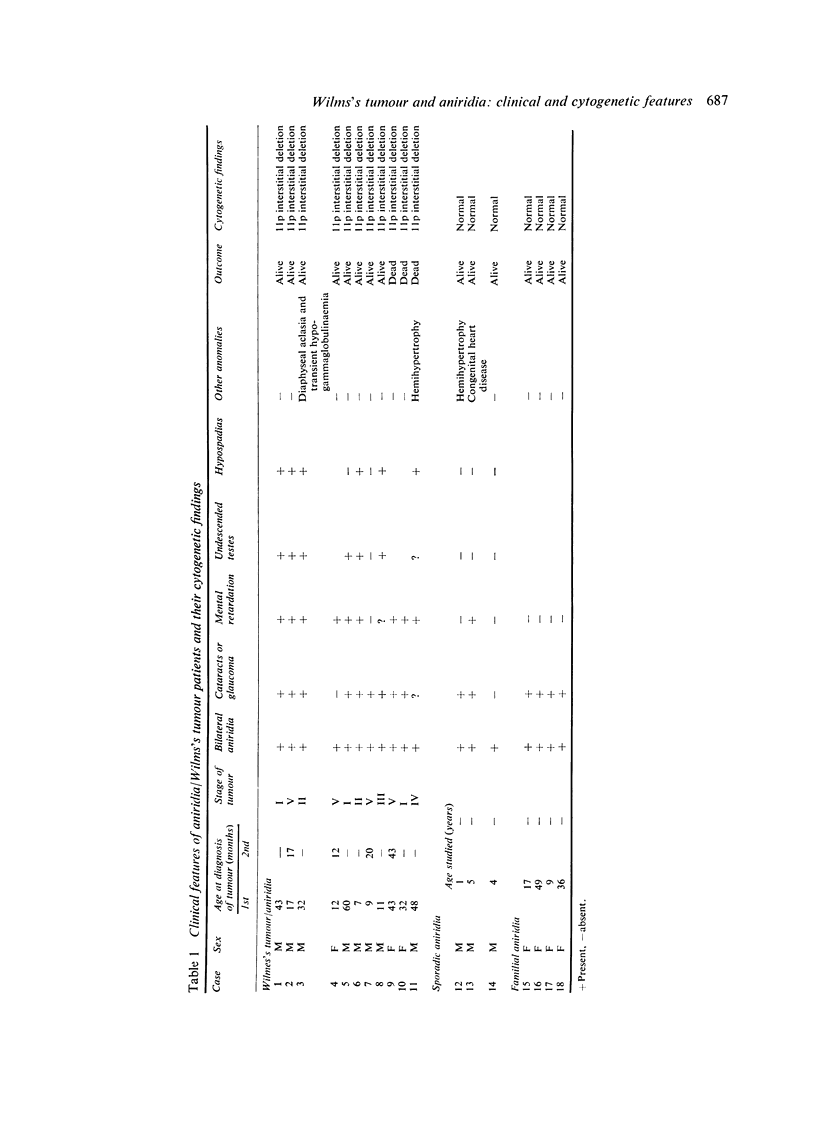
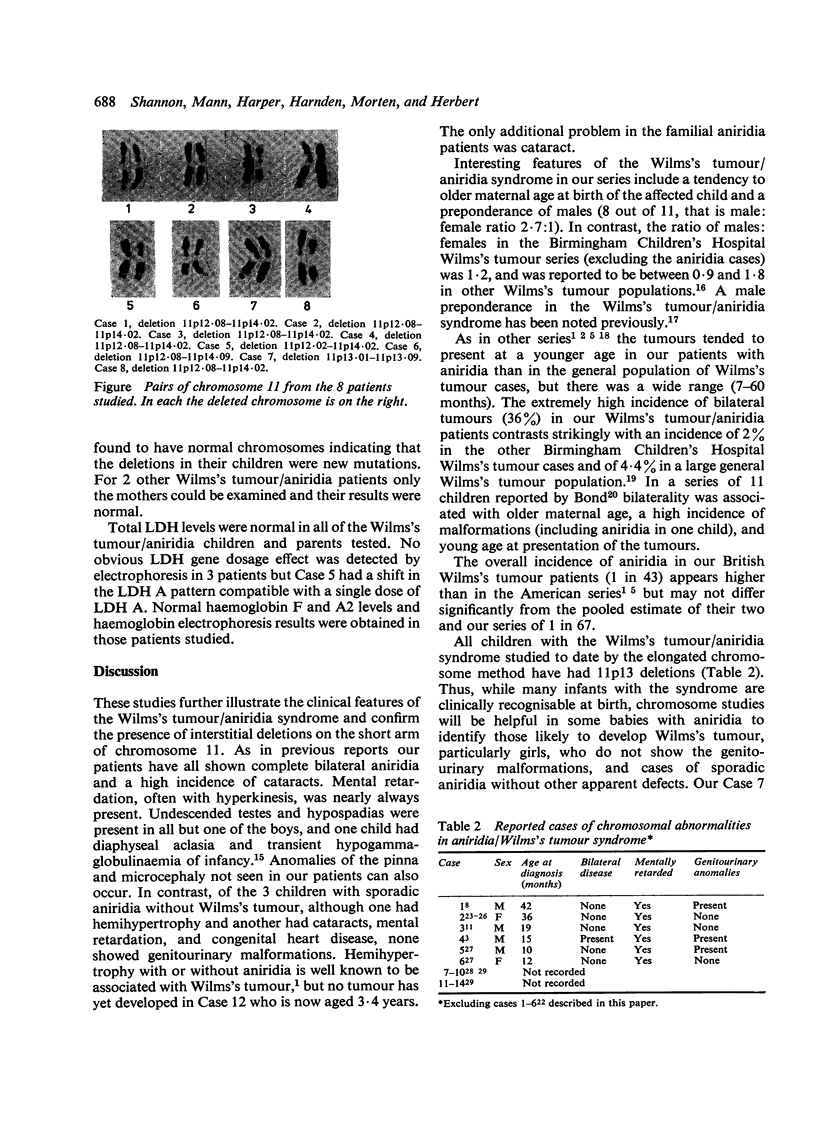
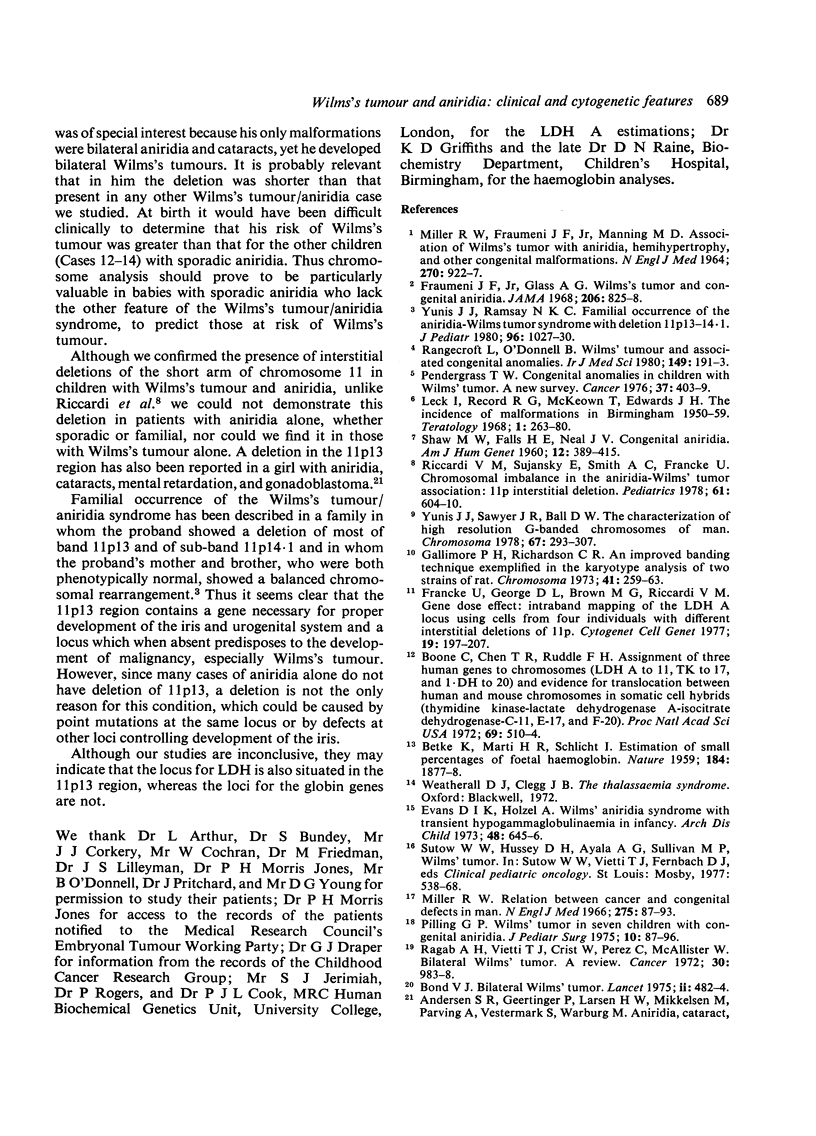
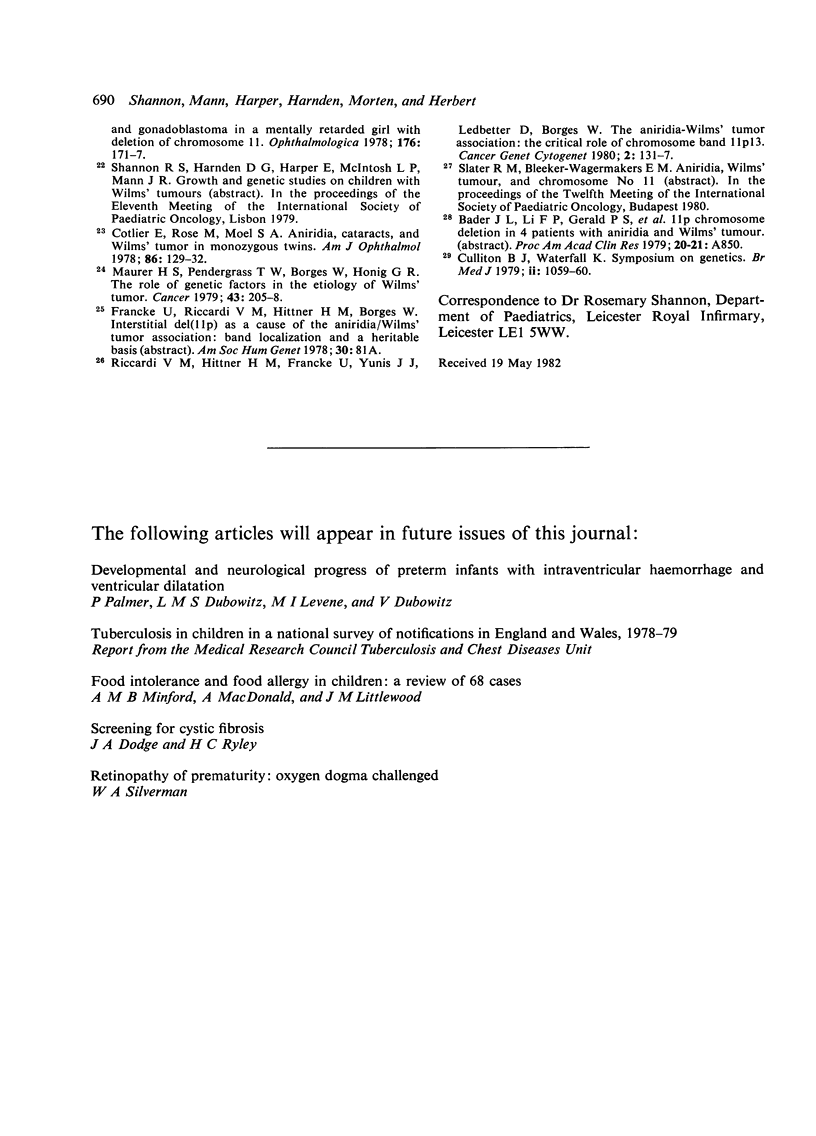
Images in this article
Selected References
These references are in PubMed. This may not be the complete list of references from this article.
- Andersen S. R., Geertinger P., Larsen H. W., Mikkelsen M., Parving A., Vestermark S., Warburg M. Aniridia, cataract and gonadoblastoma in a mentally retarded girl with deletion of chromosome II. A clinicopathological case report. Ophthalmologica. 1977;176(3):171–177. doi: 10.1159/000308711. [DOI] [PubMed] [Google Scholar]
- BETKE K., MARTI H. R., SCHLICHT I. Estimation of small percentages of foetal haemoglobin. Nature. 1959 Dec 12;184(Suppl 24):1877–1878. doi: 10.1038/1841877a0. [DOI] [PubMed] [Google Scholar]
- Bond J. V. Bilateral Wilms' tumour. Age at diagnosis, associated congenital anormalies, and possible pattern of inheritance. Lancet. 1975 Sep 13;2(7933):482–484. doi: 10.1016/s0140-6736(75)90550-4. [DOI] [PubMed] [Google Scholar]
- Boone C., Chen T. R., Ruddle F. H. Assignment of three human genes to chromosomes (LDH-A to 11, TK to 17, and IDH to 20) and evidence for translocation between human and mouse chromosomes in somatic cell hybrids (thymidine kinase-lactate dehydrogenase A-isocitrate dehydrogenase-C-11, E-17, and F-20 chromosomes). Proc Natl Acad Sci U S A. 1972 Feb;69(2):510–514. doi: 10.1073/pnas.69.2.510. [DOI] [PMC free article] [PubMed] [Google Scholar]
- Cotlier E., Rose M., Moel S. A. Aniridia, cataracts, and Wilms' tumor in monozygous twins. Am J Ophthalmol. 1978 Jul;86(1):129–132. doi: 10.1016/0002-9394(78)90029-6. [DOI] [PubMed] [Google Scholar]
- Culliton B. J., Waterfall W. K. Symposium on genetics. Br Med J. 1979 Oct 27;2(6197):1059–1060. doi: 10.1136/bmj.2.6197.1059. [DOI] [PMC free article] [PubMed] [Google Scholar]
- Evans D. I., Holzel A. Wilm's-aniridia syndrome with transient hypo-gamma-globulinaemia of infancy. Arch Dis Child. 1973 Aug;48(8):645–646. doi: 10.1136/adc.48.8.645. [DOI] [PMC free article] [PubMed] [Google Scholar]
- Francke U., George D. L., Brown M. G., Riccardi V. M. Gene dose effect: intraband mapping of the LDH A locus using cells from four individuals with different interstitial deletions of 11p. Cytogenet Cell Genet. 1977;19(4):197–207. doi: 10.1159/000130809. [DOI] [PubMed] [Google Scholar]
- Fraumeni J. F., Jr, Glass A. G. Wilms' tumor and congenital aniridia. JAMA. 1968 Oct 21;206(4):825–828. [PubMed] [Google Scholar]
- Gallimore P. H., Richardson C. R. An improved banding technique exemplified in the karyotype analysis of two strains of rat. Chromosoma. 1973;41(3):259–263. doi: 10.1007/BF00344020. [DOI] [PubMed] [Google Scholar]
- Leck I., Record R. G., McKeown T., Edwards J. H. The incidence of malformations in Birmingham, England, 1950-1959. Teratology. 1968 Aug;1(3):263–280. doi: 10.1002/tera.1420010305. [DOI] [PubMed] [Google Scholar]
- MILLER R. W., FRAUMENI J. F., Jr, MANNING M. D. ASSOCIATION OF WILMS'S TUMOR WITH ANIRIDIA, HEMIHYPERTROPHY AND OTHER CONGENITAL MALFORMATIONS. N Engl J Med. 1964 Apr 30;270:922–927. doi: 10.1056/NEJM196404302701802. [DOI] [PubMed] [Google Scholar]
- Maurer H. S., Pendergrass T. W., Borges W., Honig G. R. The role of genetic factors in the etiology of Wilms' tumor: two pairs of monozygous twins with congenital abnormalities (aniridia; hemihypertrophy) and discordance for Wilms' tumor. Cancer. 1979 Jan;43(1):205–208. doi: 10.1002/1097-0142(197901)43:1<205::aid-cncr2820430130>3.0.co;2-7. [DOI] [PubMed] [Google Scholar]
- Miller R. W. Relation between cancer and congenital defects in man. N Engl J Med. 1966 Jul 14;275(2):87–93. doi: 10.1056/NEJM196607142750208. [DOI] [PubMed] [Google Scholar]
- Pendergrass T. W. Congenital anomalies in children with Wilms' tumor: a new survey. Cancer. 1976 Jan;37(1):403–408. doi: 10.1002/1097-0142(197601)37:1<403::aid-cncr2820370152>3.0.co;2-h. [DOI] [PubMed] [Google Scholar]
- Pilling G. P. Wilms' tumor in seven children with congenital aniridia. J Pediatr Surg. 1975 Feb;10(1):87–96. doi: 10.1016/s0022-3468(75)80015-7. [DOI] [PubMed] [Google Scholar]
- Ragab A. H., Vietti T. J., Crist W., Perez C., McAllister W. Bilateral Wilms' tumor. A review. Cancer. 1972 Oct;30(4):983–988. doi: 10.1002/1097-0142(197210)30:4<983::aid-cncr2820300419>3.0.co;2-3. [DOI] [PubMed] [Google Scholar]
- Rangecroft L., O'Donnell B. Wilms' tumour and associated congenital anomalies. Ir J Med Sci. 1980 May;149(5):191–193. doi: 10.1007/BF02939138. [DOI] [PubMed] [Google Scholar]
- Riccardi V. M., Sujansky E., Smith A. C., Francke U. Chromosomal imbalance in the Aniridia-Wilms' tumor association: 11p interstitial deletion. Pediatrics. 1978 Apr;61(4):604–610. [PubMed] [Google Scholar]
- Shaw M. W., Falls H. F., Neel J. V. Congenital Aniridia. Am J Hum Genet. 1960 Dec;12(4 Pt 1):389–415. [PMC free article] [PubMed] [Google Scholar]
- Yunis J. J., Ramsay N. K. Familial occurrence of the aniridia-Wilms tumor syndrome with deletion 11p13-14.1. J Pediatr. 1980 Jun;96(6):1027–1030. doi: 10.1016/s0022-3476(80)80630-5. [DOI] [PubMed] [Google Scholar]
- Yunis J. J., Sawyer J. R., Ball D. W. The characterization of high-resolution G-banded chromosomes of man. Chromosoma. 1978 Aug 14;67(4):293–307. doi: 10.1007/BF00285963. [DOI] [PubMed] [Google Scholar]



